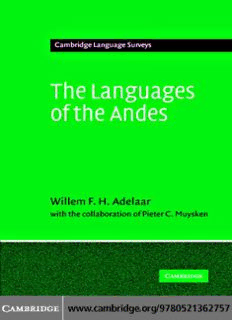
The languages of the Andes PDF
Preview The languages of the Andes
THE LANGUAGES OF THE ANDES TheAndeanandPacificregionsofSouthAmericaarehometoaremark- ablevarietyoflanguagesandlanguagefamilies,witharangeoftypologi- caldifferences.Thislinguisticdiversityresultsfromacomplexhistorical background,comprisingperiodsofgreatercommunicationbetweendif- ferentpeoplesandlanguages,andperiodsoffragmentationandindividual development.TheLanguagesoftheAndesisthefirstbookinEnglishto document in a single volume the indigenous languages spoken and for- merlyspokeninthislinguisticallyrichregion,aswellasinadjacentareas. Groupingthelanguagesintodifferentculturalspheres,itdescribestheir characteristics in terms of language typology, language contact, and the social perspectives of present-day languages. The authors provide both historicalandcontemporaryinformation,andillustratethelanguageswith detailedgrammaticalsketches.Writteninaclearandaccessiblestyle,this bookwillbeavaluablesourceforstudentsandscholarsoflinguisticsand anthropologyalike. . . isProfessorofAmerindianLanguagesandCul- tures at Leiden University. He has travelled widely in South America and has conducted fieldwork in Peru on different varieties of Quechua and minor languages of the area. He has also worked on the historical- comparativereconstructionofSouthAmericanlanguages,andsince1991 has been involved in international activities addressing the issue of lan- guage endangerment. His previously published books include Tarma Quechua(1977)andHetBoekvanHuarochir´ı(1988). . is Professor of Linguistics at the University of Nijmegen.HehastravelledwidelyintheCaribbeanandtheAndes,and waspreviouslyProfessorofSociolinguisticsandCreoleStudiesattheUni- versity of Amsterdam and Professor of Linguistics and Latin American Studies at Leiden University. He is co-editor of the Cambridge jour- nalBilingualism:LanguageandCognition,andhispreviouslypublished booksincludeBilingualSpeech:aTypologyofCode-mixing(Cambridge, 2000),andOneSpeaker,TwoLanguages(co-editedwithLesleyMilroy, Cambridge,1995). CAMBRIDGE LANGUAGE SURVEYS Generaleditors P.Austin(UniversityofMelbourne) J.Bresnan(StanfordUniversity) B.Comrie(MaxPlanckInstituteforEvolutionaryAnthropology,Leipzig) W.Dressler(UniversityofVienna) C.Ewen(UniversityofLeiden) R.Lass(UniversityofCapeTown) D.Lightfoot(UniversityofMaryland) I.Roberts(UniversityofCambridge) S.Romaine(UniversityofOxford) N.V.Smith(UniversityCollegeLondon) Thisseriesoffersgeneralaccountsofthemajorlanguagefamiliesofthe world, with volumes organised either on a purely genetic basis or on a geographicalbasis,whicheveryieldsthemostconvenientandintelligible groupingineachcase.Eachvolumecomparesandcontraststhetypological featuresofthelanguagesitdealswith.Italsotreatstherelevantgeneticre- lationships,historicaldevelopmentandsociolinguisticissuesarisingfrom theirroleanduseintheworldtoday.Thebooksareintendedforlinguists fromundergraduatelevelupwards,butnospecialknowledgeofthelan- guagesunderconsiderationisassumed.VolumessuchasthoseonAustralia andtheAmazonBasinarealsoofwiderrelevance,asthefutureofthelan- guagesandtheirspeakersraisesimportantsocialandpoliticalissues. Volumesalreadypublishedinclude ChineseJerryNorman ThelanguagesofJapanMasayoshiShibatani PidginsandCreoles(volumeI:Theoryandstructure;volumeII: Referencesurvey)JohnA.Holm TheIndo-AryanlanguagesColinMasica TheCelticlanguageseditedbyDonaldMacAulay TheRomancelanguagesRebeccaPosner TheAmazonianlanguageseditedbyR.M.WDixonandAlexandraY. Aikhenvald ThelanguagesofNativeNorthAmericaMarianneMithun TheKoreanlanguageHo-HimSohn AustralianlanguagesR.M.W.Dixon TheDravidianlanguagesBhadrirajuKrishnamurti THE LANGUAGES OF THE ANDES WILLEM F. H. ADELAAR withthecollaborationof PIETER C. MUYSKEN cambridge university press Cambridge, New York, Melbourne, Madrid, Cape Town, Singapore, São Paulo Cambridge University Press The Edinburgh Building, Cambridge cb2 2ru, UK Published in the United States of America by Cambridge University Press, New York www.cambridge.org Information on this title: www.cambridge.org/9780521362757 © Willem F. H. Adelaar and Pieter C. Muysken 2004 This publication is in copyright. Subject to statutory exception and to the provision of relevant collective licensing agreements, no reproduction of any part may take place without the written permission of Cambridge University Press. First published in print format 2004 isbn-13 978-0-511-21587-2 eBook (NetLibrary) isbn-10 0-511-21587-8 eBook (NetLibrary) isbn-13 978-0-521-36275-7 hardback isbn-10 0-521-36275-x hardback Cambridge University Press has no responsibility for the persistence or accuracy of urls for external or third-party internet websites referred to in this publication, and does not guarantee that any content on such websites is, or will remain, accurate or appropriate. CONTENTS Listoftables page x Listofmaps xiv Preface xv Orthographicconventions xvi Listofabbreviations xx 1 Introduction 1 1.1 ThelanguagesoftheAndes 4 1.2 Physicaldescription 6 1.3 Briefhistoryoftheregion 7 1.4 A brief overview of the different Andean countries 10 1.5 HistoryofthestudyoftheAndeanlanguages 15 1.5.1 Thecolonialperiod 15 1.5.2 Thenineteenthcentury 18 1.5.3 ContemporaryAndeanlinguistics 19 1.6 SourcesforthestudyofthelanguagesoftheAndes 20 1.7 GeneticrelationsofSouthAmericanIndianlanguages 22 1.7.1 Historyofclassificatoryefforts 23 1.7.2 QuechuanandAymaran,Quechumaran 34 1.7.3 Otherproposalsforindividuallanguagefamilies 36 1.7.4 TheGreenberg(1987)proposal 41 2 TheChibchaSphere 46 2.1 Thelanguagegroupsandtheirdistribution 50 2.2 ResearchonthenativelanguagesofColombia 54 2.3 Chocoan 56 2.4 Yurumanguı´60 2.5 Cuna 61 2.6 The languages of the Sierra Nevada de Santa Marta 66 vi Contents 2.7 Chimila 75 2.8 Bar´ı 80 2.9 TheMuiscalanguage 81 2.9.1 Sources 82 2.9.2 Phonology 83 2.9.3 Grammar 89 2.9.4 Lexicon 103 2.9.5 AMuiscatext 106 2.10 Tunebo(UwCuwa) 109 2.11 YukpaandMagdalenavalleyCariban 112 2.12 TheArawakanlanguagesoftheCaribbeancoast 115 2.13 Timote–Cuica 124 2.14 Jirajaran 129 2.15 Pa´ez(NasaYuwe) 130 2.16 Andaqu´ıandthelanguagesoftheUpperMagdalenavalley 138 2.17 Barbacoanlanguages 141 2.18 Kamsa´ 151 2.19 Esmeralden˜o 155 2.20 OverviewofthelanguagesoftheeasternColombianlowlands 161 3 TheIncaSphere 165 3.1 Thelanguagesandtheirdistribution 168 3.2 TheQuechuanlanguagefamily 179 3.2.1 TheQuechuahomeland 180 3.2.2 Historicaloverviewofthecolonialperiod 182 3.2.3 Dialectsituation 183 3.2.4 Quechuastudies 191 3.2.5 Phonology 194 3.2.6 Grammar 207 3.2.7 CharacteristicsoftheQuechualexicon 233 3.2.8 AsketchofanEcuadorianQuechuadialect(Salasaca) 237 3.2.9 AsketchofaPeruvianQuechuadialect(Pacaraos) 242 3.2.10 ACuzcoQuechuatextfragment 249 3.2.11 LiteraryproductioninQuechua 254 3.2.12 SocialfactorsinfluencingthefutureofQuechua 256 3.3 TheAymaranlanguagefamily 259 3.3.1 Pastandpresentdistribution 260 3.3.2 Homelandandexpansion 263 3.3.3 InternalvariationintheAymaranlanguagefamily 264 Contents vii 3.3.4 SalientfeaturesoftheAymaranlanguagefamily 267 3.3.5 Aymaraphonology 270 3.3.6 Aymaragrammar 274 3.3.7 Aymaralexicon 293 3.3.8 LiteraryproductioninAymara 296 3.3.9 Aymarasampletext 296 3.3.10 TheJaqarulanguage 301 3.3.11 Jaqarusampletext 315 3.4 TheMochicalanguage 319 3.4.1 ThesoundsofMochica 321 3.4.2 Mochicagrammar 328 3.4.3 Mochicasampletexts 344 3.5 PuquinaandCallahuaya 350 3.6 TheUru–Chipayalanguages 362 3.7 TheAtacamen˜olanguage 375 3.8 TheLule–Tonocote´language 385 3.9 ExtinctandpoorlydocumentedlanguagesoftheIncaSphere 391 3.9.1 Ecuador 392 3.9.2 NorthernPeru 397 3.9.3 NorthwesternArgentina 407 4 Thelanguagesoftheeasternslopes 411 4.1 ThePano–Tacananlanguages 418 4.2 TheArawakanlanguages 422 4.2.1 Yanesha(cid:2)phonology 424 4.2.2 TheprincipalgrammaticalfeaturesofYanesha(cid:2) 425 4.2.3 ComplexsentencesinYanesha(cid:2) 430 4.3 Tupi–Guaran´ı 430 4.4 TheJivaroanlanguages 432 4.4.1 Shuarphonology 433 4.4.2 TheprincipalgrammaticalfeaturesofShuar 435 4.4.3 ComplexsentencesinShuar 445 4.5 Cahuapana 447 4.6 Bora–Huitoto 449 4.7 TheZaparoanlanguages 451 4.8 TheTucanoanlanguages 453 4.9 SmallfamiliesandsupposedlanguageisolatesinEcuador 454 4.10 SmallfamiliesandsupposedlanguageisolatesinPeru 456 4.11 Cholo´n 460 viii Contents 4.11.1 TheCholo´nlexiconandrelationshipwithHibito 461 4.11.2 Gender-determinedlanguageuse 462 4.11.3 Cholo´nphonology 463 4.11.4 TheprincipalgrammaticalfeaturesofCholo´n 463 4.11.5 ThebasicwordorderofCholo´n 475 4.12 SmallfamiliesandsupposedlanguageisolatesinBolivia 475 4.13 Chiquitano 477 4.13.1 Gender-determinedlanguageuseinChiquitano 478 4.13.2 Chiquitanophonology 479 4.13.3 TheprincipalgrammaticalfeaturesofChiquitano 480 4.13.4 Chiquitanowordorder 488 4.14 ThelanguagesoftheChacoregion:Guaicuruan,Matacoan, ZamucoanandLengua–Mascoy 488 4.15 Quechuainfluencesoneasternslopeslanguages 499 5 TheAraucanianSphere 502 5.1 AraucanianorMapuche 508 5.1.1 Mapuchestudies 510 5.1.2 ThesoundsofMapuche 512 5.1.3 Grammar 517 5.1.4 Lexicon 537 5.1.5 Mapuchesampletext 539 5.2 TheAllentiaclanguage 544 6 ThelanguagesofTierradelFuego 550 6.1 Thelanguagesandtheirdistribution 552 6.2 Ethnohistory 555 6.3 Problemsinclassification 556 6.4 Linguisticfeatures 558 6.4.1 TheChonanlanguages 558 6.4.2 ChonoandKawesqar 564 6.4.3 Yahgan 567 6.4.4 Areal-typologicalfeaturesoftheFuegianlanguages 578 6.5 Oralliterature 580 6.6 Languagecontact 580 6.7 ATehuelchetext 582 7 TheSpanishpresence 585 7.1 CharacteristicsofAndeanSpanish 585 Contents ix 7.1.1 DemographyandtheIberiandialectalorigins 586 7.1.2 Linguisticfeatures 587 7.2 Amerindiansubstratuminfluence 589 7.3 LanguagemixtureandpidginisationintheAndesandthe Amazonbasin 602 7.4 Africaninfluences 604 7.5 LanguageplanningandpolicywithrespecttotheAmerindian languagesandtobilingualeducation 605 7.6 Andeanlanguagesinthemodernworld 608 Appendix:Inventoryoflanguagesandlanguagefamilies oftheAndeanregion 610 References 625 Authorindex 681 Indexoflanguagesandethnicgroups 690 Subjectindex 703
Description: